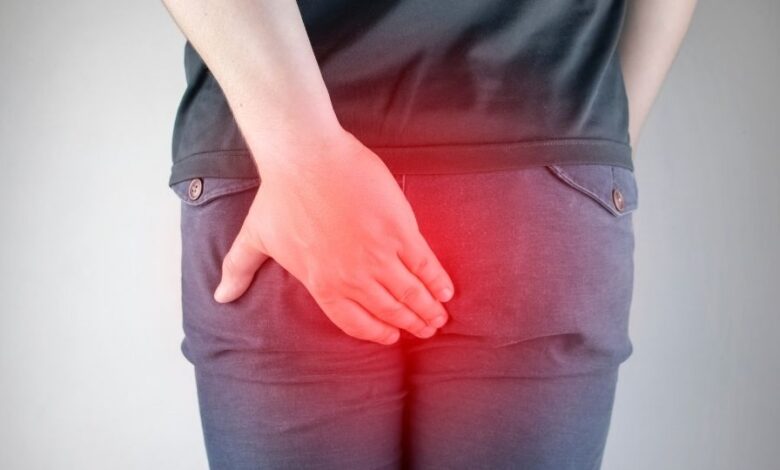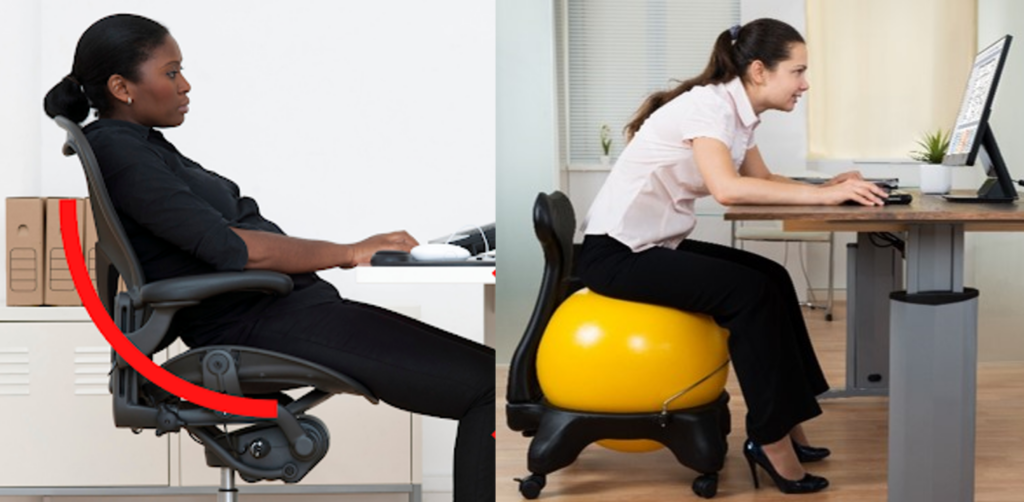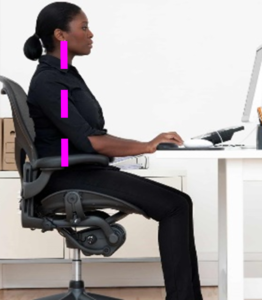When Does Tailbone Pain Start During Pregnancy?

That’s a question a LOT of people ask Google.
Does this mean that many people think that tailbone pain is an inevitable part of pregnancy that they just have to “suffer” at some point?
We are here to assure you that is not the case!
Although common, there are many things you can do to prevent or relieve tailbone pain, or coccydynia. First, let’s cover some background information on your tailbone, and what tailbone pain feels like. Then, we’ll discuss the common causes of tailbone pain during pregnancy and what you can do to prevent or alleviate the pain.
Where Is the Tailbone and What Does It Do?
The tailbone, or coccyx, is located at the very base of the spine and serves as the attachment site for tendons, ligaments, and muscles. It supports and stabilizes a person while sitting, especially when leaning back in a chair.
What does tail pain feel like?
Tailbone pain is primarily seen as pain and tenderness at the base of your spine (near the top of your lower back). The pain can range from dull and aching to sharp. This pain can be worsened by sitting for long periods of time, especially on hard or minimally-cushioned surfaces, or with certain movements such as standing up from a sitting position. The sensation may also radiate to the lower back or buttocks, making everyday activities uncomfortable.
What Causes Tail Pain?
During pregnancy, the following changes can lead to tailbone pain:
- Hormonal Changes: Pregnancy triggers the release of hormones such as relaxin, which relaxes the ligaments in the pelvis to prepare the body for childbirth. Although this is a necessary adjustment, it can also lead to increased mobility in the coccyx area, resulting in discomfort or pain.
- Increased Weight and Pressure (especially when sitting): As pregnancy progresses, the added weight of the growing fetus increases the load on the spine and pelvis. This can put extra pressure on the tailbone, especially when leaning back on a chair, or bent down. Both of these positions can increase pressure on the tailbone.

- Postural Changes: The center of gravity shifts forward and upward as the uterus expands, often causing pregnant individuals to unconsciously adjust their posture by leaning back to counterbalance (as you can see below). These adjustments can add stress to the lower back and coccyx, contributing to discomfort.

- Direct Pressure from Baby: In the later stages of pregnancy, the position of the baby can put direct pressure on the tailbone, especially if the baby is in a buttocks (feet or bottom first) position. This pressure can be uncomfortable and cause pain in the tailbone area.
- childbirth: During childbirth, the coccyx is pushed back as the baby moves through the birth canal, which can lead to bruising, dislocation, or fracture of the coccyx. Although it is more directly related to postpartum coccydyniastrain on the coccyx during childbirth can also aggravate existing pain during pregnancy.
- Previous Injuries: Individuals with a history of tailbone pain before pregnancy may find that their symptoms worsen during pregnancy due to increased strain and hormonal changes.
- Sedentary Lifestyle: Prolonged sitting, especially on hard or poorly cushioned surfaces, can worsen tailbone pain. Individuals who limit their physical activity during pregnancy, and spend more time sitting, may feel increased discomfort.
When Does Pregnancy Tail Pain Start?
As mentioned before, tailbone pain does not necessarily start to everyone during pregnancy. For those who experience tailbone pain, there is no universal timeline for its onset, although it is most commonly reported in the second and third trimesters. This variation is due to the body’s individual responses to pregnancy-related changes in weight, posture, and hormone levels.
How to Help Prevent Tailbone Pain
Prevention of tailbone pain during pregnancy involves a combination of exercises, postural adjustments, and lifestyle changes aimed at reducing stress on the tailbone. Here are some strategies:
- Maintain Neutral (Pelvic) Alignment: Practice sitting neutral alignment (with weight on your “sit” bones instead of your tailbone) and distribute your weight evenly across both hips.

- Improve Deep Core Function: Improving deep core function is the most significant things you can do to help prevent almost all pregnancy aches and pains due to the systemic effects of deep core function throughout the body. With tailbone pain in particular, the core muscles help support the pelvis and tailbone. Start with 360° Breathing (aka the #1 most effective core exercise) and practice incorporating it into your movements. Then, master Pelvic Floor Activities and practice them several times each day.
- Focus on Strength Training (especially glutes): Once your body is in neutral alignment and your deep core muscles are working properly, the next most important strategy is to focus on strength training. The physiological changes of pregnancy put a great deal of extra stress on the body, which is why there are so many “common” pregnancy ailments. The stronger you are, the better your body is at managing the increased stresses placed on it. In case of pain in the tailbone, strengthening of glutes (with exercises like squats and bridges) are especially important because they work the core to support the pelvis and tailbone. For safe and effective strength training programs at all stages of pregnancy, explore our self-guided training programs.
- Mobility Work: Stretch regularly, emphasizing gentle stretches for the lower back, hips, and pelvic area to relieve tension. Try them out mobility exercises to prepare for childbirth for some extra bang for your buck to prepare your body for an easier delivery.
- Avoid Prolonged Sitting: Take frequent breaks to stand up and move around if your job or daily routine involves long periods of sitting. When sitting, alternate between different sitting positions to relieve pressure on your tailbone.
- Mindful Movement: Be careful when moving from sitting to standing or when lifting objects. Try to bend your knees and move neutral alignment to reduce unnecessary stress on your tailbone.
How It Can Help Relieve Tail Pain
All of the above techniques also help ease the pain. In addition to those, you can incorporate the following tips to manage the pain.
- Use a Donut Cushion or Wedge Pillow: Sitting on a donut cushion or a specially designed wedge pillow can relieve pressure on the tailbone.
- Consult a Specialist: A physical therapist can provide tailored exercises, manual therapies, and advice on posture and movement to relieve pain and improve pelvic alignment. If the pain is severe or persistent, consult a specialist, such as a physiatrist or pain management doctor.
- Consider Acupuncture or Massage Therapy: Some people find relief from acupuncture or massage therapy that focuses on the pelvic area. Make sure the practitioner has experience treating pregnant clients.
Want More Resources?
As mentioned above, safe and effective strength training can be key to easing most of the aches and pains of pregnancy as it prepares the body to cope more successful government these stresses. For safe and effective total body workouts during all stages of pregnancy, explore our Pre & Postnatal Self-Guided Training Programs.
To learn how to design safe and very effective strength training programs for pre and postnatal clients, check out our industry leading Pre/Postnatal Fitness Specialist Certification.





